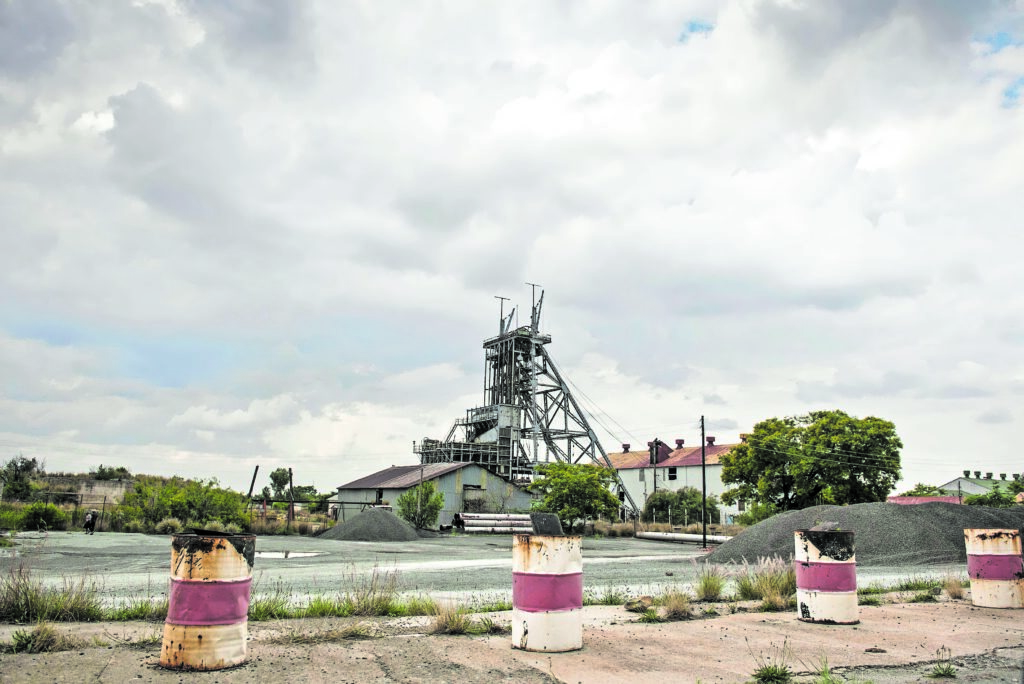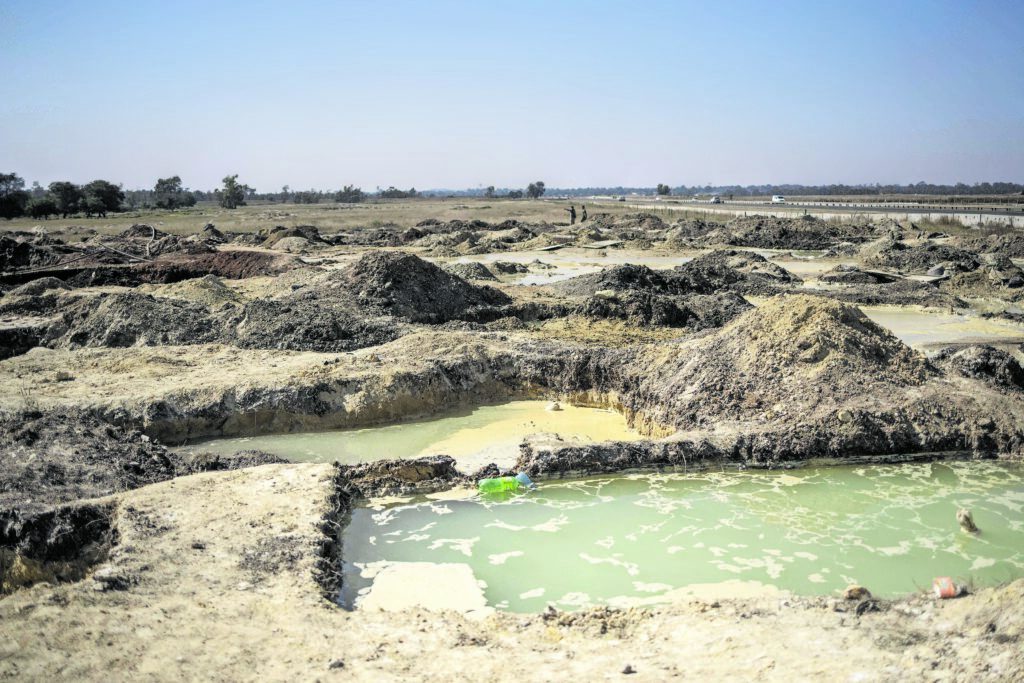Costly closure: Blyvooruitzicht Gold Mine near Carletonville closed down and along with it the village. (Delwyn Verasamy/M&G)
When the Blyvooruitzicht Gold Mine in Carletonville was abruptly liquidated eight years ago, everything changed for Pule Molefe. Overnight, operations stopped, thousands of people lost their jobs and environmental mitigation and management measures ground to a halt.
Molefe, who was working in Blyvooruitzicht’s procurement department, remembers it as a dark, bleak time.
“It was really bad. Basically, you woke up in the morning and you were told that there’s no employment for you anymore. You never planned for that and you have a family to feed.”
To survive, some people turned to small-scale, illegal mining.
“People were desperate,” Molefe says. “Everything fell apart. It was a mining community so everything was controlled by the mine: our electricity was paid by the mine, our water services and our refuse removal. Now, there was nothing.”
 Disastrous: Residents of Blyvooruitzicht village are living in limbo after the mine, the only local source of work, closed. Water, refuse and electricity services also subsequently collapsed. Photo: Madelene Cronjé
Disastrous: Residents of Blyvooruitzicht village are living in limbo after the mine, the only local source of work, closed. Water, refuse and electricity services also subsequently collapsed. Photo: Madelene Cronjé
Over the years, the number of people living in the mine village has swollen by thousands. “We were about 3000 before, now it’s easily four times that. The mine was strict about who could live in the village. Now, there’s no control of housing. People have filled the garages and Blyvoor’s office space.”
Molefe says there is a “grey area” in cases like Blyvoor. “If you go to the government for help, they say it’s private property. If you go to the mines, they say they are no longer responsible. So the community is left on their own. Then, with the liquidators, there’s so little they can do and so much they cannot do,” he says.
“I don’t think this is the right way of closing a mine because it affects so many people.”
Mariette Liefferink, chief executive of the nonprofit Federation for a Sustainable Environment, says the plight of mining-affected residents in Springs, Krugersdorp and Klerksdorp is similar to the experience of the residents of the Blyvoor village when the Grootvlei Mine in Springs, Mintails’ operations in Krugersdorp and Shiva Uranium Mine (a Gupta-owned mine) were liquidated or placed under business rescue.
“These cases represent disastrous mine closures,” she says.
Now the department of mineral resources and energy has unveiled a new mine closure strategy, which is envisioned to deal with the detrimental fallouts of mine closures. According to the strategy, mine closure must be environmentally and socially sound and economically viable. Typically the closure of mines results in often irreversible environmental degradation and social and economic hardship in surrounding mining-affected areas.
The draft strategy envisions transforming land damaged by mining into agricultural projects, tourism enterprises and the self-generation of energy by mining companies. Non-mining use of mining lands for economic programmes must be planned as an integral element of a mine’s life cycle.
 Blyvooruitzicht is a mining village, just outside of Carletonville in the North West province. (Image: Delwyn Verasamy/M&G)
Blyvooruitzicht is a mining village, just outside of Carletonville in the North West province. (Image: Delwyn Verasamy/M&G)
The draft reads: “Given the current crisis on energy supply, self-generation of energy by mining companies is a critically important aspect of a post-mining economy. The recent development where operating mines generate their own power will create a generation base that can be used to provide energy to post-mining development.” This, too, can provide sustainable energy where long-term water pumping and water treatment are required.
But Liefferink points out that crop production, including household food gardens and grazing for livestock are high-risk land uses because of the potential harm caused by the bioaccumulation of metals, including uranium, in the soil.
In its submitted comments on the draft, Tarisai Mungunyani, a lawyer at the Centre for Environmental Rights, says that in any mine closure strategy, it is people and the environment that bear the greatest risk and such strategies should address the harmful effects as a priority.
She says that closure strategies should prioritise land uses that support livelihoods and access to land and land reform as a political and economic imperative.
“Inequality in our country is sharply aggravated by the resettlement of communities to make way for mining, perpetuating centuries of dispossession.”
According to the strategy, the closure of a mine will often affect the remaining mines in that region. The unintended consequence of this could negatively affect the safe operation of neighbouring mines and potentially result in the cessation of their operations.
“The key problem area is surface water contamination, suspected groundwater contamination on a regional scale,” says the draft.
Substantial damage includes the socioeconomic effects of mine closure, air pollution by windblown dust, radioactivity, land degradation and land instability caused by undermining and seismicity and damage to biodiversity, according to the draft.
Another of the objectives is to manage water at mining sites, including a post-closure mine water strategy for the area. This will prevent the externalisation of the pumping and treatment costs of mine water to neighbouring mines, the “last man standing” or to the state.
The document details how temporary closure, or care and maintenance, can be “cynically used” as a loophole for avoiding expensive closure programmes. “The endemic invasion of derelict and abandoned mines by illegal miners has become a major social, safety, economic and legal problem for the country.”
 With no controls in place, the village’s population swelled and illegal mining operations started because people are desperate for an income. (Photo by Michele Spatari/AFP)
With no controls in place, the village’s population swelled and illegal mining operations started because people are desperate for an income. (Photo by Michele Spatari/AFP)
Estimates of “zama zama” outputs of gold production exceed R14-billion a year, making South Africa one of the largest sources of illegal gold in Africa, the draft says, noting how this activity is also rife in the platinum group metal sector and around the “plethora” of abandoned mines. The facilitation and control of legal secondary mining of waste deposits by small-scale and artisanal miners is another key aspect of mine closure, according to the draft.
Liefferink says significant concerns remain about the enforcement of the policy, given the track record of implementation of the previous mine closure strategies. She says the draft strategy needs to have teeth.
“We can compare this strategy to a Rolls-Royce, but unfortunately we only have the capacity for a Volkswagen,” Liefferink says.
Her organisation highlights how the most common practice for mining companies to avoid their closure commitment is the “pass the parcel” approach — when mines are sold close to closure to poorer-resourced companies, which relieves them of the responsibility and liability of dealing with the problems of closure. “And at the end you sit with a little scavenger company that only scavenges the last bit of resources” and doesn’t rehabilitate the environment or ensure the closure is socially and economically viable.
Stephinah Mudau, the head of environment at the Minerals Council, says in principle it welcomes and supports the draft strategy. “[It] provides a strong basis to strengthen regional collaboration between mines and various stakeholders in ensuring environmental sustainability, and socioeconomic succession during and post mine closure. The Minerals Council recommends that extensive engagements be held with the mining company experts and specialists.”